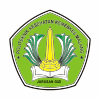Substitusi Sereal Flakes Berbasis Tepung Jali (Coix lacyma jobi L.) Modifikasi HMT (Heat Moisture Treatment) dan Tepung Kecambah Kedelai (Glycine max L.) sebagai Produk Sarapan Anak Usia Sekolah Obesitas (Kajian Mutu Kimia, Mutu Gizi, dan Mutu Organolep
Abstract
Latar belakang: Di Indonesia terdapat 17 sampai dengan 59 persen anak usia sekolah yang tidak sarapan, anak sekolah yang melewatkan sarapan berisiko 2,8 kali lebih besar menderita obesitas. Prevalensi obesitas (IMT/U) anak usia sekolah (5 – 12 tahun) di Indonesia sebesar 9,2 persen meningkat sebanyak 1,2 persen dibanding tahun 2013. Salah satu produk siap santap yang dapat dikonsumsi anak usia sekolah saat sarapan ialah sereal flakes. Kandungan protein dan lemak jali lebih tinggi dibandingkan beras, jagung, millet dan sorgum. Kadar serat pangan biji jali (4,3 persen) lebih tinggi dibandingkan jagung (2,8 persen). Metode HMT digunakan agar menghasilkan tepung jali dengan karakteristik yang cocok diaplikasikan untuk flakes. Kedelai mengandung sumber protein nabati mencapai 35 persen. Tepung kecambah kedelai dengan blancing air mengandung kadar serat tertinggi (30 persen) dibanding tepung kecambah kacang-kacangan lain. Metode: Metode penelitian eksperimental dengan 3 taraf perlakuan dan 3 pengulangan. Hasil: Semakin rendah proporsi tepung jali modifikasi HMT dan semakin tinggi proporsi tepung kecambah kedelai maka kadar air, abu, protein, lemak, dan serat kasar flakes semakin meningkat namun kadar karbohidrat semakin menurun. Semakin rendah proporsi tepung jali modifikasi HMT dan semakin tinggi proporsi tepung kecambah kedelai maka tingkat kesukaan panelis terhadap aroma, rasa, dan tekstur flakes semakin menurun kecuali pada parameter warna panelis lebih menyukai P2. Simpulan: Substitusi sereal flakes berbasis tepung jali modifikasi HMT dan tepung kecambah kedelai memberikan pengaruh yang signifikan terhadap mutu kimia, mutu gizi, dan mutu organoleptik aroma. Namun memberikan pengaruh yang tidak signifikan terhadap mutu organoleptik warna, rasa dan tekstur. Taraf perlakuan P2 (75:25) ditentukan sebagai taraf perlakuan terbaik.
References
2. Sidiartha dan Pratiwi. 2020. Hubungan Antara Sarapan dengan Obesitas pada Anak Usia 6 – 12 Tahun. Jurnal Medika Udayana, 9(5): 13 – 17.
3. Nurmala, T. 2011. Potensi dan Prospek Pengembangan Jali (Coix lacryma-jobi L ) sebagai Pangan Bergizi Kaya Lemak untuk Mendukung Diversifikasi Pangan Menuju Ketahanan Pangan Mandiri. Pangan 20 (1): 41 – 48.
4. Ambarsari, I., Endrasari, R., dan Hidayah, R. 2020. Kandungan Nutrisi Dan Kualitas Sensoris Produk Minuman Sereal Sarapan Berbasis Flakes Jagung, Jali, dan Sorgum. Jurnal Penelitian Pascapanen Pertanian, 17(2): 108 – 116.
5. Krisnawati. 2017. Kedelai sebagai Sumber Pangan Fungsional. Iptek Tanaman Pangan, 12 (1): 57 – 65.
6. Aminah, S. dan Hersoelistyorini, W. 2012. Karakteristik Kimia Tepung Kecambah Serealia dan Kacang-kacangan dengan Variasi Blanching. https://jurnal.unimus.ac.id/index.php/psn12012010/article/view/513, diakses pada 24 Agustus 2021.
7. Hartoyo, A. dan Sunandar, F. H. 2006. Pemanfaatan Tepung Komposit Ubi Jalar Putih (Ipomea batatas L.) Kecambah Kedelai (Glycine max Merr.) dan Kecambah Kacang Hijau (Virginia radiate L.) sebagai Substituen Parsial Terigu dalam Produk Pangan. Jurnal Teknologi dan Industri Pangan, 17 (1): 50 – 57.
8. Nasrulloh, N., Amar, M. I., dan Simanungkalit, S. F. 2021. Komposisi Proksimat, Serat Kasar dan Organoleptik Tempe Campuran Kedelai dan Jali. Jurnal Ilmu Pangan dan Hasil Pertanian, 5(1): 93 – 105.
9. Rahmawati, W. N., Nasrullah, N., dan Puspita, I.D. 2021. Pengaruh Subtitusi Biji Jali Terhadap Kandungan Gizi, Metionin dan Lisin Tempe Kedelai. Jurnal Gizi dan Kesehatan, 5(2): 140 – 151.
10. Histifarina, D., Rahadian, D., Ratna, P. N., dan Liferdi. 2020. Hanjeli utilization as a functional food to support food sovereignance. IOP Conference Series: Earth and Environmental Science, 443(1). https://doi.org/10.1088/1755-1315/443/1/012105
11. Situmorang, C., Swamilaksita, D. P., dan Anugrah, N. 2018. Substitusi Tepung Kacang Hijau dan Tepung Kacang Kedelai pada Pembuatan Bean Flakes Tinggi Serat dan Tinggi Protein sebagai Sarapan Sehat. https://digilib.esaunggul.ac.id/public/UEU-Undergraduate-10907-9.%20Manuskrip.Image.Marked.pdf, diakses pada 29 Agustus 2021.
12. Sari, Y. K. dan Adi, A. C. 2017. Daya Terima, Kadar Protein, dan Zat Besi Cookies Substitusi Tepung Daun Kelor dan Tepung Kecambah Kedelai. Media Gizi Indonesia, 12(01): 27 – 33.
13. Koswara. 2009. Teknologi Pengolahan Kedelai (Teori dan Praktek). Jakarta: Pustaka Sinar Harapan
14. Yulfianti, R., Ginting, E., dan Utomo, J. S. 2020. Karakteristik Fisiko-Kimia dan Sensoris Susu Kecambah beberapa Varietas Unggul Kedelai. Buletin Palawija, 18(2): 83 – 93.
15. Ghani, M., Kulkarni P. K. P., Song, J. T., Shannon, J. G., Lee, J. D. 2016. Soybean Sprouts: A Review of Nutrient Composition, Health Benefits and Genetic Variation. Plant Breeding and Biotechnology, 4(4): 398-412.
16. Rudianto. 2014. Studi Pembuatan dan Analisis Zat Gizi pada Produk Biskuit Moringa Oleifera dengan Substitusi Tepung Daun Kelor (Tesis). Universitas Hasanudin, Makassar.
17. Kementerian Kesehatan RI. 2017. Tabel Komposisi Pangan Indonesia. Jakarta: Direktorat Gizi Masyarakat.

This work is licensed under a Creative Commons Attribution-ShareAlike 4.0 International License.








